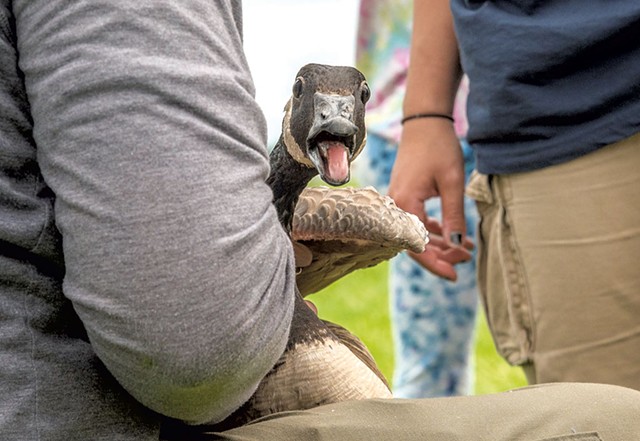
- Courtesy Of Vermont Fish & Wildlife/maria Gigliello
- A goose ready for banding
I arrived at the Dead Creek Wildlife Management Area in Addison early on July 3 and quickly realized I was underdressed for the wild goose chase my editor had sent me on.
I'd gone for the city-slicker-does-Vermont summer getup: shorts, T-shirt, Adidas sneakers, Lake Monsters ball cap. Other volunteers wore more appropriate goose-hunting-in-a-muddy-swamp outfits: long camouflage pants and knee-high rubber muck boots.
"Maybe shorts and sneakers aren't the best," wildlife biologist John Mlcuch remarked when he saw my outfit. After all, we'd be walking through large muddy puddles, along riverbeds and plains with tall grass up to our knees.
Luckily, I had a pair of jeans in my car that I'd packed for the long weekend ahead, so I got changed before the 8 a.m. start time. I'd also brought along some gloves, a rarity among the dozens of volunteers, including kids, who showed for the annual event.
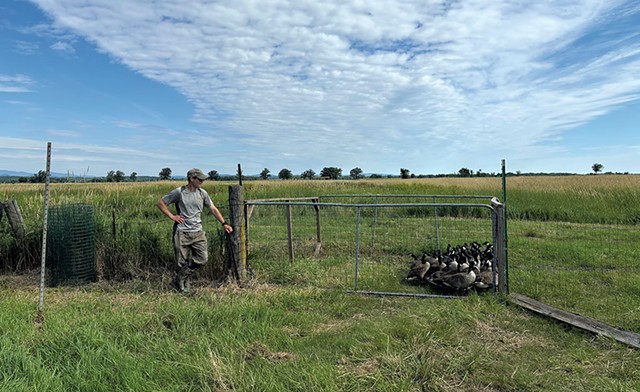
- Jack McGuire
- A Fish & Wildlife staffer with captured geese
Our "hunt" wasn't going to involve any actual killing, but it was bound to get messy. About 50 volunteers, including me, a Seven Days summer intern, had gathered with Vermont Department of Fish & Wildlife staff to corral Canada geese into a pen and place metal bands on their legs. The annual banding enables researchers to track important information about the health of the population. Similar efforts monitor varieties of birds all around the world.
We volunteers wouldn't just serve as glorified herding dogs. We'd also get the daunting opportunity to hold a wild goose, something even petting zoos do not offer. While Fish & Wildlife bands many bird species across the state, the Dead Creek event is the only one where members of the public can handle birds.
Fish & Wildlife staffers have some fun, too. The workers had a pool to see who could come the closest to guessing the number of male and female geese banded that day.
I kept in mind that the goose-wrangling was not just fun and games. Wildlife management program manager David Sausville had explained to me the importance of logging the approximate age and sex of the geese to monitor how they're faring.
The Vermonters I was with had gotten up early on a Wednesday to help out.
"I live over in Cabot and left at 5:30 this morning," one volunteer, Paul Coates, told me. "My wife, Rhonda, she's the crazy goose lady. She's been in love with geese forever, and when we saw the opportunity to come down and actually handle them, I said, 'She's got to do this.'"
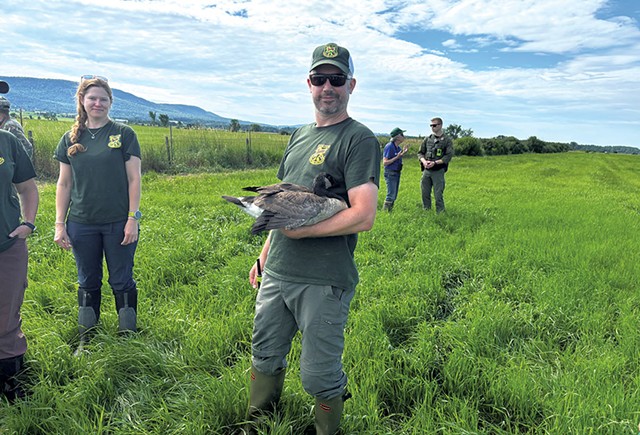
- Jack McGuire
- A Fish & Wildlife employee holding a goose
We started early because the experience can cause anxiety for the animals, and heat stress can make things worse, Sausville said.
The summer months provide an opportunity for these banding operations. While many associate Canadian geese with the flying Vs the flocks make in the sky as they head south in the fall, the birds can't always fly.
"From mid-June to mid-July, all the geese are essentially flightless," wildlife biologist Andrew Bouton explained to the volunteers. "Most waterfowl species lose all of their flight feathers at the same time ... [and] geese are also raising their young." Because the goslings — and mature geese — can't fly, it allows "for us to basically herd them," Bouton said.
The organizers gave us brief instructions and split us up into groups. Each would start in a different area, surround the geese and then slowly come together, herding the birds toward a pen.
"When we get to the part where you're actually looking at the geese and they're looking at you, they don't want to be with us, so they're gonna walk in the other direction," Mlcuch told us.
Mlcuch led me and about 30 other volunteers to a field that was a five-minute drive from the Dead Creek visitor center. Fortunately, my front-wheel drive Kia Soul made it across the bumpy gravel road.
Once assembled, our group formed a line and spread out in six-foot intervals. Even though there were no geese in sight, Fish & Wildlife staff told us to walk forward together.
For about 20 minutes, we trudged through mud and potentially tick-infested long grass without seeing any geese.
Dead Creek is part of the Atlantic flyway, one of four main "highways" that migratory birds follow in the U.S. The U.S. government has been banding and tracking waterfowl and songbirds since the 1920s. Volunteers have been invited to help band Canada geese at Dead Creek for 45 years, Sausville said. The 3,000-acre wildlife area hosts around 200 species of birds throughout the year and is a destination for bird-watchers.
The geese at Dead Creek are a "resident" population that summers there. During the 1950s, populations of Canada geese declined in the U.S., so many states started to raise geese in captivity, according to Bouton. The birds generally spend the colder months in the mid-Atlantic region.
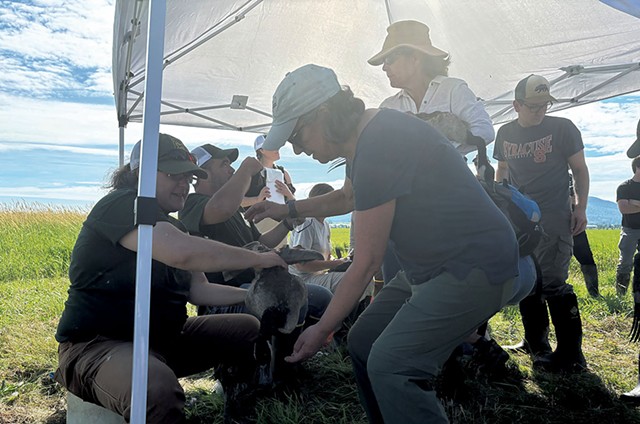
- Jack McGuire
- A volunteer reclaiming a banded goose
"They leave in the winter if all the water freezes up, but during the summer, they breed in our local water bodies," Bouton said.
As we walked, all conversation suddenly stopped. In the distance, we could see the other groups coming towards us, a small flock of geese waddling before them. I expected the birds to behave like swans and honk or hiss at us while we tried to corral them, but the geese meekly shuffled away from us, appearing nervous and distressed as people closed in on them. Eventually, we surrounded the birds and locked them in a fenced area.
Volunteers lined up single file. One by one, wildlife staff picked up a goose and handed it to a volunteer. Department officials instructed us to grab the feet in our left hand and the torso with our right. The birds, which weighed about 10 pounds, did not resist or struggle much. Children carried smaller geese with the help of their parents, while adults held full-size birds.
"You want to hold them with a firm grip," a staffer said while handing me a goose. "If they feel you loosen up, they'll squirm."
Geese in hand, volunteers made their way to the banding station, where experienced staffers took the animals and held them firmly between their legs. Their colleagues jotted down the estimated age and the sex of each goose and used pliers to wrap a silver metal band around its leg, just above the webbed foot. The department is testing some birds for avian flu, but not geese.
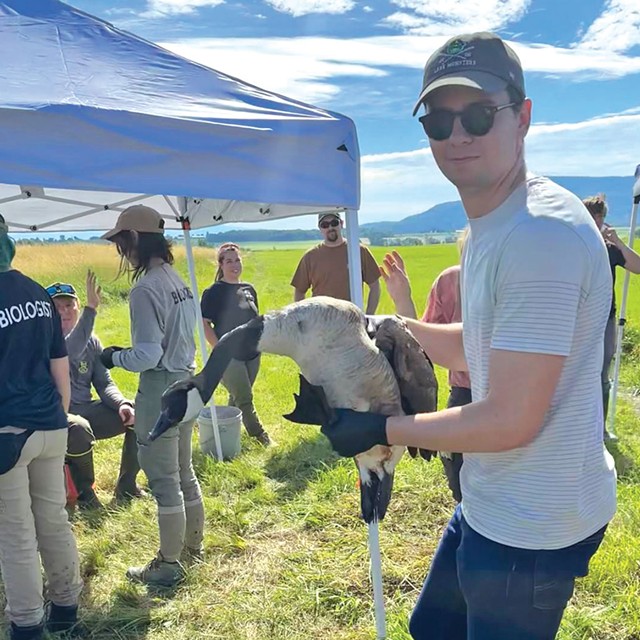
- Courtesy Of Natalee Kneeland
- Jack McGuire with a goose
Each band has a unique set of numbers that identify the bird and where it was tagged. Vermont has a hunting season for Canada geese, so the wildlife department encourages people who harvest bands on dead birds to report them to help track age and sex ratios for the population.
"If you ever find a band or harvest the band, call or go online to report that number. It's vital information," Bouton said.
Once a bird had its band, a volunteer took it to a "release pen" about 30 yards away. The short walk gave participants a brief opportunity to become acquainted with their assigned goose. While I probably won't run into mine again, I'll relish the brief moments of contact we had — and I was sure to get a picture with it. Despite its predicament, my goose stayed calm, which I admired.
Others, too, seemed fond of their birds. "Can we keep it as a pet?" I heard a young boy ask his parents.
About two hours after the operation began, we'd counted 18 male and 29 female geese. The workers opened the gates to the release pen, and the flock waddled back into the grassy field, no worse for wear.
And with that, we volunteers dispersed, heading for our cars to migrate back to our daily lives.






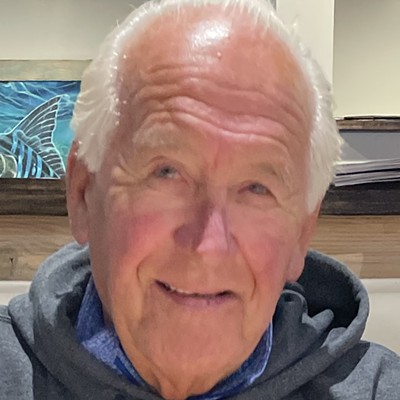



Comments
Comments are closed.
From 2014-2020, Seven Days allowed readers to comment on all stories posted on our website. While we've appreciated the suggestions and insights, right now Seven Days is prioritizing our core mission — producing high-quality, responsible local journalism — over moderating online debates between readers.
To criticize, correct or praise our reporting, please send us a letter to the editor or send us a tip. We’ll check it out and report the results.
Online comments may return when we have better tech tools for managing them. Thanks for reading.